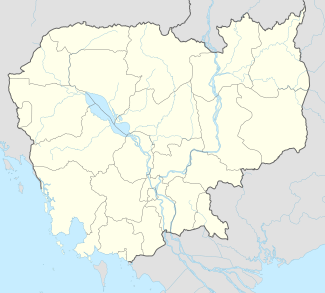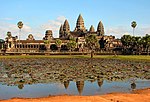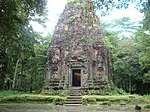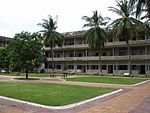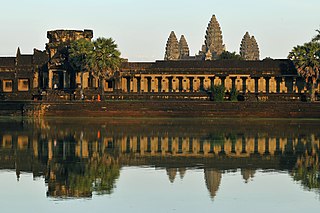
Khmer architecture, also known as Angkorian architecture, is the architecture produced by the Khmers during the Angkor period of the Khmer Empire from approximately the later half of the 8th century CE to the first half of the 15th century CE.

Kampong Thom is a province (khaet) of Cambodia. It borders the provinces of Siem Reap to the northwest, Preah Vihear to the north, Stung Treng to the northeast, Kratie to the east, Kampong Cham and Kampong Chhnang to the south, and the Tonle Sap to the west.

Preah Vihear is a province (khaet) of Cambodia. It borders the provinces of Oddar Meanchey and Siem Reap to the west, Kampong Thom to the south and Stung Treng to the east. Its northern boundary forms part of Cambodia's international border with Thailand and Laos. Its capital is Preah Vihear.
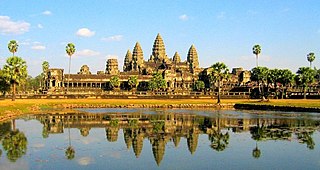
Siem Reap, officially Siemreap, is a province (khaet) of Cambodia. It borders the provinces of Oddar Meanchey to the north, Preah Vihear and Kampong Thom to the east, Battambang to the south, and Banteay Meanchey to the west. Its capital and largest city is Siem Reap.

Preah Vihear Temple is an ancient Khmer Hindu temple that was built by the Khmer Empire and is on the top of a 525-metre (1,722 ft) cliff in the Dângrêk Mountains, in the Preah Vihear province, Cambodia.

Koh Ker is a remote archaeological site in northern Cambodia about 120 kilometres (75 mi) away from Siem Reap and the ancient site of Angkor. It is a jungle filled region that is sparsely populated. More than 180 sanctuaries were found in a protected area of 81 square kilometres (31 sq mi). Only about two dozen monuments can be visited by tourists because most of the sanctuaries are hidden in the forest and the whole area is not fully demined.
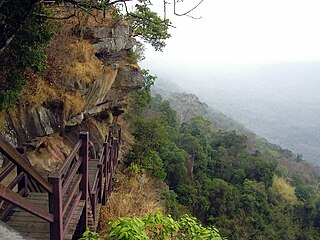
Khao Phra Wihan National Park is a protected natural area in Sisaket Province, Thailand, that contains numerous ruins of the 11th century Khmer Empire. The park lies 98 km (61 mi) south of the town of Sisaket, at the end of Thai highway 221. Sited on a red stone cliff that is part of the Dangrek mountain range on the southern edge of the Khorat Plateau, it abuts the international border between Thailand's Sisaket Province and Cambodia's Preah Vihear Province. The name of the cliff in the Royal Thai General System of Transcription is Pha Mo I Daeng (ผามออีแดง). The park was established on 20 March 1998, with an area of 81,250 rai ~ 130 square kilometres (50 sq mi)

The Cambodian–Thai border dispute began in June 2008 as part of a century-long dispute between the Kingdom of Cambodia and the Kingdom of Thailand involving the area surrounding the 11th-century Preah Vihear Temple, in the Dângrêk Mountains between Choam Khsant District, Preah Vihear Province of northern Cambodia and the Kantharalak District, Sisaket Province of northeastern Thailand.

Sambor Prei Kuk (Isanapura) is an archaeological site in Cambodia located in Kampong Thom Province, 30 km (19 mi) north of Kampong Thom, the provincial capital, 176 km (109 mi) east of Angkor and 206 km (128 mi) north of Phnom Penh. The now ruined complex dates back to the Pre-Angkorian Chenla Kingdom, established by king Isanavarman I as central royal sanctuary and capital, known then as "Isanapura". In 2017, Sambor Prei Kuk was declared a UNESCO World Heritage Site.
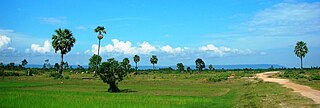
Phnom Kulen is a mountain range and a part of Phnom Kulen National Park in Siem Reap Province, Cambodia.

The archeological complex of Preah Khan of Kampong Svay, also known as Prasat Bakan or Bakan Svay Rolay, is located 100 km east of Angkor, in Preah Vihear province, Cambodia. It stands as the largest single religious complex ever built during Angkorian Era, as its exterior enclosure is over 22 km square, even if the isolated location makes it one of the less-visited Angkorian sites.
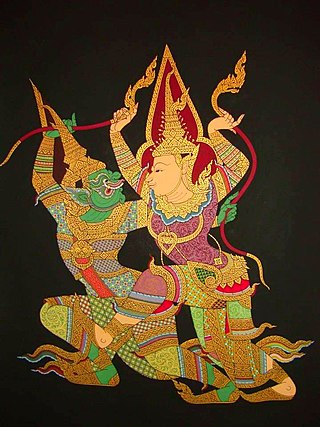
Lakhon Khol or Khmer Masked Theatre is a dance drama genre that is performed in Cambodia.

Tourism in Cambodia is one of the most important sectors in the country's economy. In 2013, tourism arrivals increased by 17.5 percent year on year, with business travelers increasing 47 percent.
Īśānavarman or Yīshēnàxiāndài was a king of the kingdom of Chenla in 7th century, which would later become the Khmer Empire. He was the son of, and successor to Mahendravarman.

Bilateral relations between Cambodia and Thailand date to the 13th century during the Angkor Era. The Thai Ayutthaya Kingdom gradually displaced the declining Khmer Empire from the 14th century, importing much of its customs and culture. French protectorateship separated Cambodia from modern Thailand at the turn of the 19th–20th centuries, and diplomatic relations between the modern states were established on 19 December 1950.
Sachchidanand Sahai is an Indian epigraphist, writer and the scientific advisor to the Government of Cambodia for restoration of Angkor Wat and the Temple of Preah Vihear, known for his knowledge on Khmer civilization. He was honored by the Government of India, in 2012, with the fourth highest Indian civilian award of Padma Shri.
